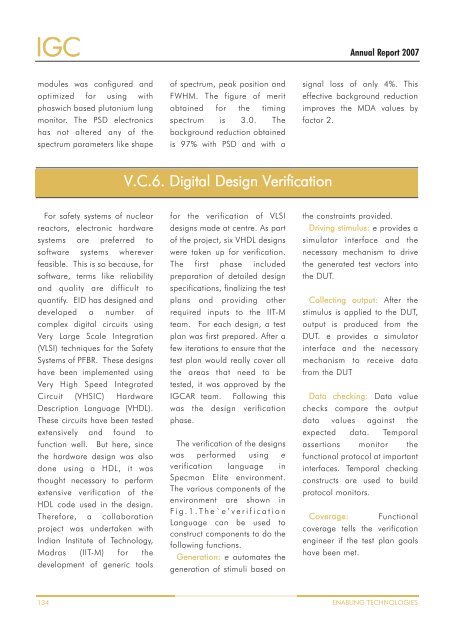IGCAR : Annual Report - Indira Gandhi Centre for Atomic Research
IGCAR : Annual Report - Indira Gandhi Centre for Atomic Research
IGCAR : Annual Report - Indira Gandhi Centre for Atomic Research
You also want an ePaper? Increase the reach of your titles
YUMPU automatically turns print PDFs into web optimized ePapers that Google loves.
IGC<br />
<strong>Annual</strong> <strong>Report</strong> 2007<br />
modules was configured and<br />
optimized <strong>for</strong> using with<br />
phoswich based plutonium lung<br />
monitor. The PSD electronics<br />
has not altered any of the<br />
spectrum parameters like shape<br />
of spectrum, peak position and<br />
FWHM. The figure of merit<br />
obtained <strong>for</strong> the timing<br />
spectrum is 3.0. The<br />
background reduction obtained<br />
is 97% with PSD and with a<br />
signal loss of only 4%. This<br />
effective background reduction<br />
improves the MDA values by<br />
factor 2.<br />
V.C.6. Digital Design Verification<br />
For safety systems of nuclear<br />
reactors, electronic hardware<br />
systems are preferred to<br />
software systems wherever<br />
feasible. This is so because, <strong>for</strong><br />
software, terms like reliability<br />
and quality are difficult to<br />
quantify. EID has designed and<br />
developed a number of<br />
complex digital circuits using<br />
Very Large Scale Integration<br />
(VLSI) techniques <strong>for</strong> the Safety<br />
Systems of PFBR. These designs<br />
have been implemented using<br />
Very High Speed Integrated<br />
Circuit (VHSIC) Hardware<br />
Description Language (VHDL).<br />
These circuits have been tested<br />
extensively and found to<br />
function well. But here, since<br />
the hardware design was also<br />
done using a HDL, it was<br />
thought necessary to per<strong>for</strong>m<br />
extensive verification of the<br />
HDL code used in the design.<br />
There<strong>for</strong>e, a collaboration<br />
project was undertaken with<br />
Indian Institute of Technology,<br />
Madras (IIT-M) <strong>for</strong> the<br />
development of generic tools<br />
<strong>for</strong> the verification of VLSI<br />
designs made at centre. As part<br />
of the project, six VHDL designs<br />
were taken up <strong>for</strong> verification.<br />
The first phase included<br />
preparation of detailed design<br />
specifications, finalizing the test<br />
plans and providing other<br />
required inputs to the IIT-M<br />
team. For each design, a test<br />
plan was first prepared. After a<br />
few iterations to ensure that the<br />
test plan would really cover all<br />
the areas that need to be<br />
tested, it was approved by the<br />
<strong>IGCAR</strong> team. Following this<br />
was the design verification<br />
phase.<br />
The verification of the designs<br />
was per<strong>for</strong>med using e<br />
verification language in<br />
Specman Elite environment.<br />
The various components of the<br />
environment are shown in<br />
Fig.1.The`e ’verification<br />
Language can be used to<br />
construct components to do the<br />
following functions.<br />
Generation: e automates the<br />
generation of stimuli based on<br />
the constraints provided.<br />
Driving stimulus: e provides a<br />
simulator interface and the<br />
necessary mechanism to drive<br />
the generated test vectors into<br />
the DUT.<br />
Collecting output: After the<br />
stimulus is applied to the DUT,<br />
output is produced from the<br />
DUT. e provides a simulator<br />
interface and the necessary<br />
mechanism to receive data<br />
from the DUT<br />
Data checking: Data value<br />
checks compare the output<br />
data values against the<br />
expected data. Temporal<br />
assertions monitor the<br />
functional protocol at important<br />
interfaces. Temporal checking<br />
constructs are used to build<br />
protocol monitors.<br />
Coverage: Functional<br />
coverage tells the verification<br />
engineer if the test plan goals<br />
have been met.<br />
134 ENABLING TECHNOLOGIES

















